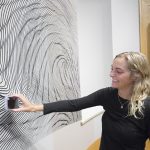
“De Money series no. 1,” Fuji crystal archival print by George Osodi (born Nigeria). National Museum of African Art, Smithsonian Institution
“Earth Matters: Land as Material and Metaphor in the Arts of Africa” opens at Bowdoin College Museum of Art on October 15 and continues through to March 6, 2016. The first major pan-African art exhibition in Maine, Earth Matters also represents the first major exhibition to explore how African artists have used their work over the course of two centuries to mediate their relationship with the land upon which they live, work and frame their days. Organized by Karen E. Milbourne, Curator at the National Museum of African Art, Smithsonian Institution, the exhibition brings together approximately 50 exceptional works of art, created by artists from seventeen African nations, from the turn of the 19th century, when the international slave trade became illegal, to the present. The show uses five thematic sections to demonstrate the different ways in which the earth is interpreted through art: The Material Earth, Power of the Earth, Imagining the Underground, Strategies of the Surface, and Art as Environmental Action. These categories provide vantage points from which to examine the poignant relationships expressed by African artists to the land, whether it be to earth as sacred, medicinal, discoverable, or vulnerable.
The exhibition brings together two centuries of art inspired by both the physical and cultural African landscape. It includes pieces by internationally recognized and emerging contemporary artists from the continent and diaspora who draw on the land for inspiration, such as Sammy Baloji, Christine Dixie, Hassan Echair, Ingrid Mwangi, William Kentridge, George Osodi, Georgia Pappageorge, Jo Ratcliffe, Berni Searle, and Tchif. Historic works comprise a broad range of sculptural and two-dimensional objects that include reliquary guardian figures from Gabon, healing figures from the Republic of the Congo, vessels from Cameroon; masks and personal sumptuary from central and western Africa, and religious and political staffs from across Africa.
“We, each of us, make choices everyday that relate to the land beneath our feet,” said Milbourne. “Where we come from informs who we consider ourselves to be. What we throw out affects what this land of ours will be in the future. These issues are not African; they are global, but looking through the lens of Africa we can all better understand the human relationship to the landscape and its significance to the history of African art.”

“Untitled “/ the series “World Under Pressure,” 2011, aluminum object, by Batoul S’himi, born Morocco. Collection of the Artist.
“We are proud to bring this important exhibition of African art to Bowdoin College,” remarked Bowdoin College Museum of Art Co-Director, Anne Collins Goodyear. “It provides an important perspective on how artists have negotiated their changing relationship to the land for over two centuries, and provides insight not only into the pan-African histories, but also into concerns familiar to American audiences grappling with how the meaning of the land around us has evolved over time.” Co-Director Frank Goodyear continues: “We are increasingly reminded of the vast reach of our international networks, both physical and virtual. Earth Matters returns our focus to the power of the ground beneath our feet while also demonstrating the political, spiritual, and aesthetic claims it has on the imagination in Africa as well as here in Maine.”
After opening in 2013 to great acclaim at the National Museum of African Art Museum in Washington, DC, the show traveled to UCLA’s Fowler Museum in Los Angeles. The importance of the exhibition continues to grow, taking on new nuance in each region of the country in which it has appeared. It has special significance in the context of Bowdoin College, with its strong commitment to the study of the earth and the environment. With immigrants from several African nations now settling in Mid-Coast Maine, this exhibition has special significance for the region. Above all, the exhibition demonstrates how art can frame critical, and ancient, human questions concerning our own relationship to the world around us politically, historically, and aesthetically. As Milbourne noted shortly after unveiling the project: “This exhibition speaks to issues that affect us all – whether in Africa, the United States, or elsewhere – and these artists are remarkable in their ability to help us understand our human relationship to the land upon which we live, breath, and frame our days. … It is my hope that by beginning to understand the different materials of the earth, what they can and have meant, where they come from, how the land has been interpreted, and how we protect it, we might better understand ourselves.
Lecture and Reception
Karen Milbourne will deliver a lecture about the exhibition on Thursday, October 22 at 4:30 p.m. in Beam Classroom, Visual Arts Center, Bowdoin College to celebrate the opening of the exhibition at the Bowdoin College Museum. Following the lecture, from 5:30 to 7:00 p.m., the Bowdoin College Museum of Art hosts a Fall Open House and invites the public to view the Earth Matters exhibition. Both events are open to the public free of charge.
About the Curator
Milbourne has been a curator at the National Museum of African Art, Smithsonian Institution since May 2008. Her expertise includes the arts and pageantry of western Zambia and contemporary African art. Since joining the museum, she has curated the exhibition, “Artists in Dialogue: António Ole and Aimé Mpane,” and provided the in-house supervision for the exhibition “Yinka Shonibare MBE”. Her exhibition, “Artists in Dialogue II: Sandile Zulu and Henrique Oliveira” opened in 2011.
Catalogue
A fully illustrated catalogue by Karen Milbourne, with contributions by George Osodi, whose work appears in the exhibition, and other leading contemporary artists, accompanies the exhibition and is available at the museum shop.
Support
Earth Matters: Land as Material and Metaphor in the Arts of Africa is organized by the Smithsonian National Museum of African Art. Major sponsorship for Earth Matters has been provided by the government of the Gabonese Republic. Additional support was provided by the Smithsonian Institution Consortia for Valuing World Cultures and for Understanding the American Experience. At Bowdoin the exhibition is presented through the generosity of the Davis Family Foundation, the Grace L. Barney Residual Trust, the Stevens L. Frost Endowment Fund, and the Elizabeth B. G. Hamlin Fund.
Fully accessible, the Bowdoin College Museum of Art is open to the public free of charge from 10:00 a.m. to 5:00 p.m. on Tuesday through Saturday; 10:00 a.m. to 8:30 p.m. on Thursday, and from 1:00 p.m. to 5:00 p.m. on Sunday. Closed Mondays.
